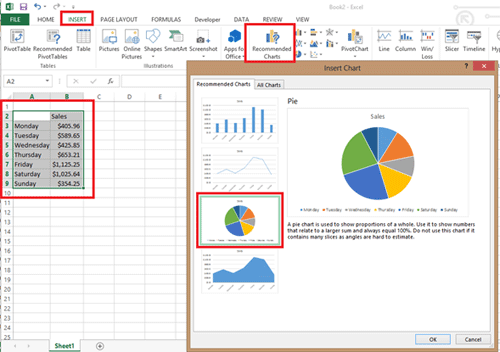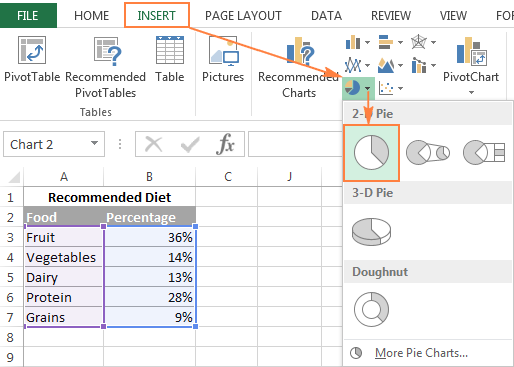

#HOW DO YOU MAKE A PIE CHART IN EXCEL 2013 CODE#
We want to write code which will work on any chart we do this by creating a variable which holds the reference to a Chart.Ĭreate a variable to refer to a Chart inside a ChartObject: Dim cht As Chart Writing code to work on either chart type The sections in bold are the same, which shows that once we have got inside the Chart, the DOM is the same. Sheets("Sheet1").ChartObjects("Chart 1").Chart. To change the chart title text, we would reference the two types of chart differently: This may seem confusing initially, but there are good reasons for this.

For example, a chart can be an embedded chart of the face of a worksheet, or as a separate sheet. One of the things which makes the DOM for charts complicated is that many things exist in many places. With this knowledge, we can refer to any element of any chart using Excel’s DOM. Sheets("Sheet1").ChartObjects("Chart 1").Height = 300 We must include the Sheet into the hierarchy for Excel to know what you want to do. The parent of a ChartObject is a Sheet, and the Parent of a Sheet is a Workbook. In the DOM, the ActiveWorkbook does not contain ChartObjects, so Excel cannot find Chart 1. ActiveWorkbook.ChartObjects("Chart 1").Height = 300

While the following code may look acceptable, it will not work. ActiveWorkbook.Sheets("Sheet1").ChartObjects("Chart 1").Height = 300Įach item in the object hierarchy must be listed and separated by a period (. To change the height of Chart 1, on Sheet1, we could use the following. Therefore, to change a cell color to red, we would reference this as follows: ActiveWorkbook.Sheets("Sheet1").Range("A1").Interior.Color = RGB(255, 0, 0)Ĭharts are also part of the DOM and follow similar hierarchical principles.

The Document Object Model (DOM) is a term which describes how things are structured. By applying the principles and methods in this post, you will be able to do almost anything you want with charts in Excel using VBA. It is not feasible to provide code for every scenario you might come across there are just too many options. As a result, some of the code presented in this post may not work with versions before Excel 2013. For example, the AddChart2 method replaced the AddChart method. In Excel 2013, many changes were introduced to the charting engine and DOM. Understanding Excel’s Document Object Model (DOM) is essential to understand how VBA can be used with charts. While it might be tempting to skip straight to the section you need, I recommend you read the first section in full. But once you’ve mastered it, you’ll know the situations when VBA is the best option. The short code snippets below will help you apply some of the most common chart options with VBA (and hopefully turn those hours into minutes).īut don’t let me fool you into thinking that using VBA is quick and easy, it’s not. When we want to apply those hundreds of settings to lots of charts, it can take hours and hours of frustrating clicking. This is great for creating precisely the visualization we want but can be time-consuming to apply. We’ll only be going over the basic chart here, but keep this in mind.Charts and graphs in Excel have hundreds of different options. There are many different kinds of pie charts, and they each have distinct visual advantages. That makes it easier for you to present and for them to interpret.
#HOW DO YOU MAKE A PIE CHART IN EXCEL 2013 HOW TO#
A box plot, for example, might leave audiences scratching their heads.īut nearly everyone knows how to read a pie chart. Some graphs and charts include complicated information and aren’t intuitively clear. It requires little additional explanation. That allows viewers to analyze the data in a snap.Īnd that’s what you’re using a chart for in the first place, isn’t it?ģ. The way in which data is presented by a pie chart makes it very easy to make comparisons quickly. Pie charts are great for showing both a value and a proportion for each category. Many charts specialize in showing one thing, like the value of a category. It can show a lot of information at once. If not, though, here are a few reasons you should consider it:ġ. If you’re here, you’re probably already convinced that a pie chart is the best way to present your data.


 0 kommentar(er)
0 kommentar(er)
